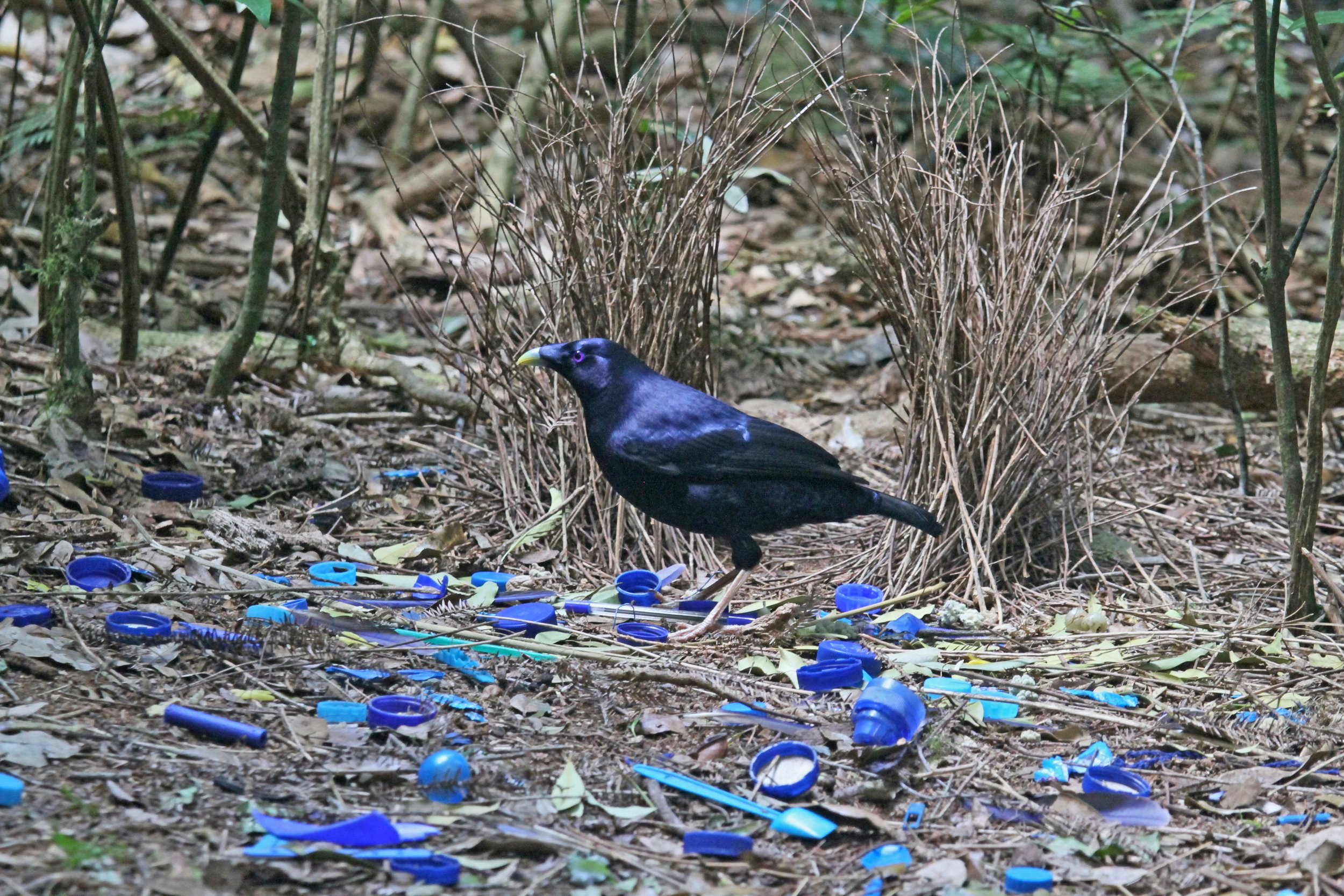The Feel of a Word: bowerbird
The bowerbird was an intriguing discovery to the European settlers with its habit of decorating its bower with small blue objects, such as shells, leaves, bright feathers, little bones, and occasionally a shiny article stolen from a camp or dwelling. There are two main types of bower: the maypole bower, in which a number of sticks are grouped around a central sapling, and the avenue bower, in which the sticks are arranged on both sides of a path leading to a square which was, from the early 1900s to the 1950s, referred to as a bowerbird’s playground. This was an anthropomorphism which we would disapprove of these days as sentimental. We know that the bower is an important part of the mating practices of the species. But in the early 1900s such romanticisation of Australian flora and fauna was fashionable. The bowerbird’s love of things blue and willingness to steal to get them was an idea that became entrenched. Even in Blinky Bill the subject came up with Mrs Koala hiding her blue slippers because the visitor (a bowerbird) might steal them.
By the 1920s bowerbird became a synonym for ‘collector’, although usually it was a collector who lacked taste and who collected small colourful objects in a mindless fashion. The Argus, in an article called Collectors – Human and Feathered, said sternly: ‘Collecting is an atavism. It is a disease which is shared by children, connoisseurs, and bower-birds.’
An article reprinted from The Spectator in 1894 accused all men of being either bowerbirds or not bowerbirds. The bowerbird male is the one who always has a hammer in his hand and who cannot speak because his mouth is full of tacks, as he surveys the walls for yet another spot to ornament. Indeed he is described as being on ‘a crusade of destructive ornamentation’.
Almost at the same time, but possibly only in Australia, bowerbird became a synonym for a petty thief. The bowerbird travelled in the same territory as the scrounger but the scrounger went through discarded items looking for something that they could use, whereas the bowerbird picked up perfectly good items that belonged to someone else. In Bowyangs and Boomerangs there is mention of a man whose nickname was ‘the Bower Bird’ ‘on account of his natural tendency to pick up anything bright.’ One night it was a case of cheap watches. At this point the bowerbird is a thief, and the derived verb to bowerbird makes it even clearer. This exasperated comment came from the Barrier Reef Days of 1948: ‘What a mess-up things would be if we couldn’t put a thing down and turn our backs without someone bower-birding it. ‘ This sense has disappeared, possibly because of the tides of fashion in underworld slang, possibly because we have less contact with bowerbirds than we used to and have lost the awareness of their thieving habits.
The notion of the bowerbird as a collector of dubious taste has lingered on with a distinction made between the magpie buyer and the bowerbird buyer. The magpie is an impulse buyer, gathering a little bit of everything they fancy, whereas the bowerbird goes for anything colourful in a mindless way. The Women’s Weekly of January 1965 warned its readers against magpie buying of clothes because they would end up with a wardrobe where nothing goes with anything else. The bowerbird buyers ended up with an assortment of junk.
The bowerbird in this period also covered someone who was an inveterate hoarder. Sometimes this was understandable. In certain situations people were known to grab extras of whatever was available so that, if the need arose, they would have the item required. Stocking up in this fashion was seen as a sensible thing to do. But bowerbirds were uncontrollable hoarders whose collecting instincts sprang from a mental disorder.
By the end of the 20th century the idea of a bowerbird as a collector is still there but the thieving aspect has disappeared, and we are more likely to make reference to a bowerbird in a phrase rather than use the word as a direct synonym for ‘collector’. We describe someone as a bit of a bowerbird, or say that they collect like a bowerbird, or that they have bowerbird tendencies or habits or behave like a bowerbird.
It is not just objects that the bowerbird collects but also ideas, images, thoughts and inspirations. Frank Moorhouse commented: All my novels are an accumulation of detail. I’m a bit of a bowerbird.
It seems that bowerbird has lost the place it once had as a lexical item of Australian English and signifies just the bird — if we are lucky enough to find one. If only we had more of them in our backyards stealing our teaspoons and bottle tops we might have remained more alive to the notion of the bowerbird as a mad collector or a thief.
